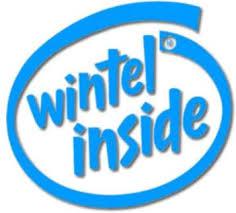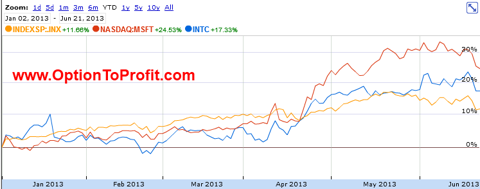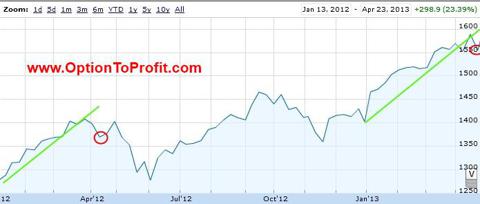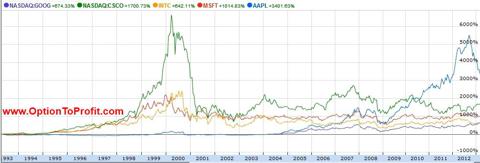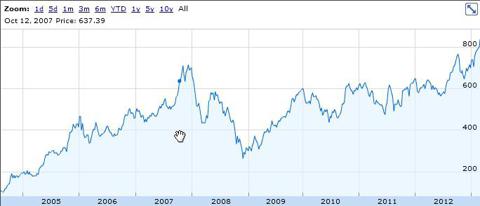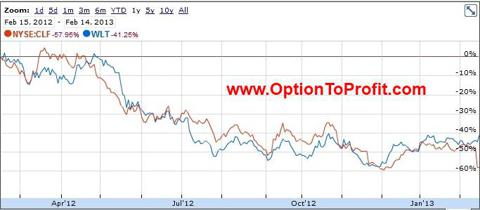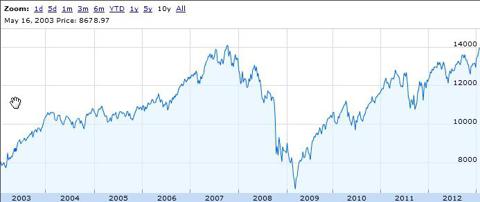
I don’t know about other people, but I’m getting a little more nervous than usual watching stocks break the 16000 level on the Dow Jones and the 1800 level on the S&P 500.
What’s next 5000 NASDAQ? Well that’s not so ludicrous. All it would take is 4 years of 6% gains and we would could set the time machine back to a different era.
In hindsight I know what I would do at the 5000 level.
For those old enough to remember the predictions of Dow 35000 all we need is a repeat of the past 56 months and we’re finally there and beyond.
This being a holiday shortened trading week adds a little bit to the stress level, because of the many axioms you hear about the markets. The one that I believe has as much validity as the best of them is that low volume can create artificially large market moves. When so many are instead focusing on the historical strength of markets during the coming week, I prefer to steer clear of any easy guide to riches.
When faced with a higher and higher moving market you could be equally justified in believing that momentum is hard to stop as you could believe that an inflection point is being approached. The one pattern that appears clear of late is that a number of momentum stocks are quickly decelerating when faced with challenges.
When I find myself a little ill at ease with the market’s height, I focus increasingly on “beta,” the measure of a stock’s systemic risk compared to the overall market. I want to steer clear of stock’s that may reasonably be expected to be more volatile during a down market or expectations of a declining market.
As a tool to characterize short term risk beta can be helpful, if only various sources would calculate the value in a consistent fashion. For example, Tesla (TSLA), which many would agree is a “momentum” stock, can be found to have a beta ranging from 0.33 to 1.5. In other words, depending upon your reference source you can walk away believing that either Tesla is 50% more volatile than the market or 67% less volatile.
Your pick.
While “momentum” and “beta” don’t necessarily have correlation, common sense is helpful. Tesla or any other hot stock du jour, despite a reported beta of 0.33, just doesn’t seem to be 67% less volatile than the overall market, regardless of what kind of spin Elon Musk might put on the risk.
During the Thanksgiving holiday week I don’t anticipate opening too many new positions and am focusing on those with low beta and meeting my common sense criteria with regard to risk. Having had many assignments to close out the November 2013 option cycle I decided to spread out my new purchases over successive weeks rather than plow everything back in at one time and risk inadvertently discovering the market’s peak.
Additionally, I’m more likely to look at either expanded option possibilities or monthly options, rather than the weekly variety this week. In part that’s due to the low premiums for the week, but also to concerns about having positions with options expiring this week caught in a possible low volume related downdraft and then being unable to find suitable new option opportunities in future weeks. If my positions aren’t generating revenue they’re not very helpful to me.
As usual, the week’s potential stock selections are classified as being in Traditional, Double Dip Dividend, Momentum and “PEE” categories this week (see details).
While eschewing risk may be in order when you think a market top is at hand, sometimes risky behavior can be just the thing when it comes to assembling a potentially profitable mix of stocks. In this case the risky behavior comes from the customers of Lorillard (LO), Philip Morris (PM) and Molson-Coors (TAP).
With word that Europeans may finally be understanding the risks associated with tobacco and may be decreasing use of their ubiquitously held cigarettes, Philip Morris shares had a rough week. The 6% drop accompanying what should be good news from a public health perspective brings shares back to a much more inviting level. Shares did successfully test an $85 support level and subsequently bounced back a bit too much for my immediate interest, but I would welcome another move toward that level, particularly as I would prefer an entry cost right near a monthly strike level.
Lorillard, on the other hand, has essentially no European exposure, but perhaps in sympathy gave up just a little bit from its 52 week high after a sustained run higher over the past 6 weeks. While there is certainly downside risk in the event of a lower moving market, shares do go ex-dividend this week and think of all of those people lighting up after a hearty Thanksgiving meal. The near term risk factors identified for Europe aren’t likely to have much of an impact in the United States market, where the only real risk factors may be use of the products.
That Thanksgiving meal may very well be complemented with a product from Molson Coors. I imagine there will also be those using a Molson Coors product while using a Lorillard product, perhaps even dousing one in the other. Shares, which are down nearly 5% from its recent highs go ex-dividend this week. Because of the strike prices available, Molson Coors is one position that I may consider using a November 29, 2013 option contract, as many more strike levels are available, something that is useful when attempting to capture both a decent option premium and the dividend, while also enticing assignment of shares.
Speaking of risky behavior, the one exception to the central theme of staying away from high beta names is the consideration of adding shares of Walter Energy (WLT). While the last 9 months have seen its shares plummet, the last three months have been particularly exciting as shares had gone up by as much as 75%. For those with some need for excitement this is certainly a candidate, with a beta value 170% greater than the average of all other recommended positions this week, the stock is no stranger to movement. But speaking of movement, although I don’t look at charts in any depth, there appears to be a collision in the making as the 50 dma is approaching the 200 dma from below. Technicians believe that is a bullish indicator. Who knows. What I do know is that the coal, steel and iron complex, despite a downgrade this past Friday of the steel sector, has been building a higher base and I believe that the recent pullback in Walter Energy is just a good opportunity for a quick trade, perhaps using the sale of puts rather than covered calls.
While not falling into the category of risky behavior, Intel’s (INTC) price movement this week certainly represents odd behavior. Not being prone to exceptionally large moves of late on Thursday it soared 3%, which by Intel’s standards really is soaring. It then fell nearly 6% the following day. While the fall was really not so odd given that Intel forecast flat revenues and flat operating profits, it was odd that the price had gone up so much the previous day. Buying on Thursday, in what may have been a frenzied battle for shares was a nice example of how to turn a relatively low risk investment into one that has added risk.
But with all of the drama out of the way Intel is now back to a more reasonable price and allows the ability to repurchase shares assigned the previous week at $24 or to just start a new position.
While I would have preferred that Joy Global (JOY) had retreated even further from its recent high, its one year chart is a nearly perfect image of shares that had spent the first 6 months of the year above the current price and the next 6 months below the current price, other than for a brief period in each half year when the relationship was reversed. Joy GLobal is an example of stock have a wide range of beta reported, as well, going from 1.14 to 2.17. However, it has also traded in a relatively narrow range for the past 6 months, albeit currently near the high end of that range.
With earnings scheduled later in the December 2013 option cycle there is an opportunity to attempt to thread a needle and capture the dividend the week before earnings and avoid the added risk. However, I think that Joy Global’s business, which is more heavily reliant on the Chinese economy may return to its recent highs as earnings are delivered.
Lowes (LOW) reported earnings this past week, and like every previous quarter since the dawn of time the Home Depot (HD) versus Lowes debate was in full force and for yet another quarter Lowes demonstrated itself to be somewhat less capable in the profit department. However, after its quick return to pricing reality, Lowes is once again an appealing portfolio addition. I generally prefer considering adding shares prior to the ex-dividend date, but the share price slide is equally compelling.
Hewlett Packard (HPQ) is one of those stragglers that has yet to report earnings, but does so this week. Had I known 35 years ago that a classmate would end up marrying its future CEO, I would likely not have joined in on the jokes. It is also one of those companies that I swore that I would never own again as it was one of my 2012 tax loss positions. I tend to hold grudges, but may be willing to consider selling puts prior to earnings, although the strike price delivering a 1% ROI, which is my typical threshold, is barely outside of the implied price move range of 8%. It’s not entirely clear to me where Hewlett Packard’s future path may lead, but with a time perspective of just a week, I’m not overly concerned about the future of the personal computer, even if Intel’s forecasts have ramifications for the entire industry.
Lexmark (LXK) is a company that I like to consider owning when there is also an opportunity to capture a dividend. That happens to be the case this week. When it announced that it was getting out of the printer business investors reacted much as you would have imagined. They dumped shares, which for most people are electronically maintained and not in printed form. After all, why own a printer company that says that printers are a dead end business? Who knew that Lexmark had other things in mind, as it has done quite nicely focusing on business process and content management solutions. While it has been prone to large earnings related moves or when shocking the investment community with such news as it was abandoning its most recognizable line of business, it has also been a rewarding position, owing to dividends and option premiums. However, always attendant is the possibility of a large news related move that may require some patience in awaiting recovery.
Finally, I find myself thinking about adding shares of eBay (EBAY) again this week, just as last week and 10 other times this past year. Perhaps I’m just obsessed with another CEO related missed opportunity. Shares didn’t fare too well based upon an analyst’s report that downgraded the company saying that shares were “range bound at $49-$54.” While that may have been the equivalent of a death siren, for me that was just validation of what had been behind the decision to purchase and repurchase shares of eBay on a regular basis. While being range bound is an anathema to most stock investors, it is a dream come true to a covered option writer.
Happy Thanksgiving.
Traditional Stocks: eBay, Intel, Lowes, Philip Morris
Momentum Stocks: Joy Global, Walter Energy
Double Dip Dividend: Lexmark (ex-div 11/26), Lorillard (ex-div 11/26), Molson-Coors (ex-div 11/26)
Premiums Enhanced by Earnings: Hewlett Packard (11/26 PM)
Remember, these are just guidelines for the coming week. The above selections may become actionable, most often coupling a share purchase with call option sales or the sale of covered put contracts, in adjustment to and consideration of market movements. The overriding objective is to create a healthy income stream for the week with reduction of trading risk.

 Some things are just unappreciated until they’re gone.
Some things are just unappreciated until they’re gone.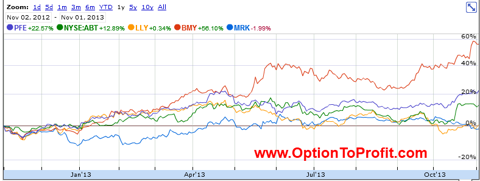
 “There’s always a calm before the storm” is a fairly well known saying that doesn’t always accurately define a sequence of events.
“There’s always a calm before the storm” is a fairly well known saying that doesn’t always accurately define a sequence of events.  This week may have marked the last time Ben Bernanke sits in front of far less accomplished inquisitors in fulfilling his part of the obligation to provide congressional testimony in accordance with law.
This week may have marked the last time Ben Bernanke sits in front of far less accomplished inquisitors in fulfilling his part of the obligation to provide congressional testimony in accordance with law. The hard part about looking for new positions this week is that memories are still fresh of barely a week ago when we got a glimpse of where prices could be.
The hard part about looking for new positions this week is that memories are still fresh of barely a week ago when we got a glimpse of where prices could be.